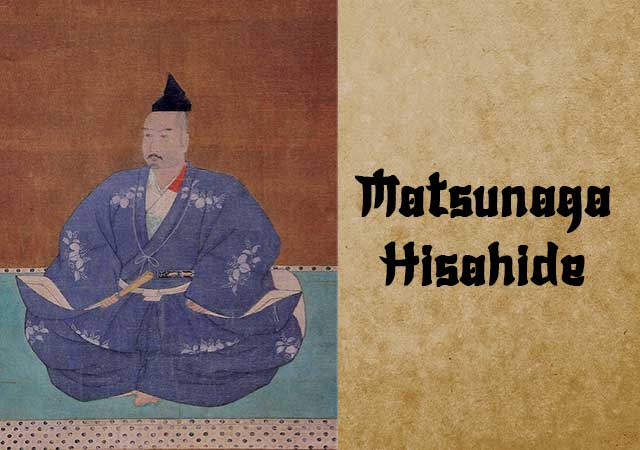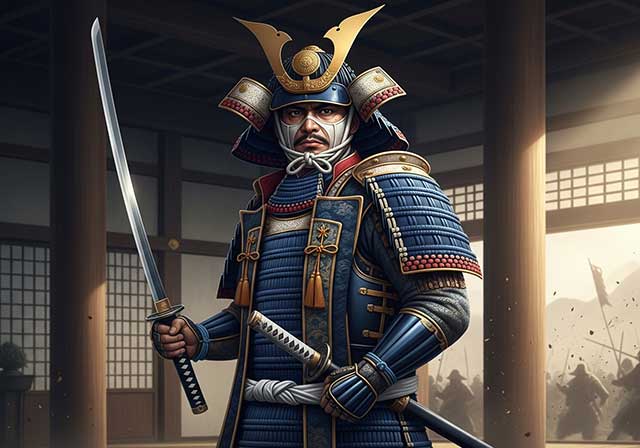
The Sengoku period daimyo Matsunaga Hisahide has been historically portrayed as a nefarious schemer, an aged and devious character, wreaking havoc on lives and property—an archetypal villain. Despite these depictions prevalent in modern plays, TV dramas, movies, and traditional woodblock prints, he was, in reality, a tall, handsome man of education and a patron of the arts when he died at the age of 68.
Born in 1508 in what is now Nishikyo-ku, Kyoto City, Hisahide served as a retainer to Miyoshi Nagayoshi, also known as Chokei, the Lord of Awa and Settsu, and one of the most influential figures of his era. Hisahide enjoyed the trust of the Miyoshi clan and held roles as a clan representative and later as governor at the Imperial Court in Kyoto. Between 1561 and 1564, three of Chokei’s brothers and his son and heir Yoshioki died under mysterious circumstances, paving the way for Hisahide to claim power and domains in 1564, though his involvement in these deaths remains speculative.
The Miyoshi clan wielded significant influence over the shogunate, manipulating the Ashikaga Shoguns, but tensions escalated, leading to the death of Shogun Yoshiteru. Matsunaga Hidehisa, under the Miyoshi’s influence, played a role in this event, resulting in the installation of the infant Yoshihide as the new shogun.
Hisahide later aligned with warlord Oda Nobunaga as he expanded his influence in Kyoto, offering him a renowned tea implement. Despite his initial loyalty, Hisahide conspired against Nobunaga in 1573 alongside the Miyoshi. However, the alliance with Miyoshi Yoshitsugu fell apart, leading Hisahide back to Nobunaga's side. He participated in the siege of Ishiyama Hongan-ji but eventually abandoned his post and returned to his lands in Yamato and Shigisan Castle.
Accused of treachery, Nobunaga demanded Hisahide's head and the prized tea container "Hiragumo." Facing Oda troops, Hisahide smashed the tea implement and committed seppuku in Shigisan Castle's tower keep. The castle was subsequently destroyed by Oda forces.
While Hisahide faced character assassination for alleged acts such as undermining his former masters and the rumored burning of Todai-ji, it's crucial to consider the biases of the victors and foreign missionaries at the time, who vilified him. His unassuming grave can be found in Daruma-ji Temple, Oji-cho, Nara.
See also
-
Uemura Masakatsu

Masakatsu was a member of the Uemura clan and the son of Uemura Masatada; from an early age he served Tokugawa Ieyasu. During the Ikkō-ikki uprising in Mikawa Province in 1563, having converted from the Jōdo Shinshū Buddhist sect to the Jōdoshū sect, he took part in suppressing the rebels. After these events, Masakatsu was appointed a military governor and was granted land holdings. According to a number of sources, he was one of the so-called “Three Governors of Mikawa” (Mikawa sanbugyō), together with Amano Yasukage (1537–1613) and Koriki Kiyonaga (1530–1608).
-
Tomoe Gozen

Gozen is regarded as one of the few historically documented examples of true female warriors of feudal Japan, known as onna-musha or onna-bugeisha. Although Japanese history records countless women who at various times were forced to take up arms—for example, in defense of their castles—Tomoe Gozen was, without any doubt, a genuinely skilled and accomplished fighter. She was the wife of Kiso (Minamoto) Yoshinaka, although The Tale of the Heike describes her more as a female vassal. Yoshinaka rose in rebellion against the Taira clan and, in 1184, captured Kyoto after his victory at the Battle of Kurikawa. After the Taira were driven into the western provinces, Yoshinaka began insistently asserting that he alone was worthy of assuming leadership of the Minamoto clan and taking on the mantle of its head.
-
Tachibana Muneshige

Tachibana Muneshige was born the eldest son of Takahashi Shigetane, one of the principal retainers of the Ōtomo clan and commander of Iwaya Castle. In childhood, he bore the name Senkumamaru. His early years coincided with a period of intense military confrontation between the Ōtomo clan and other powerful warrior houses of Kyūshū—namely the Shimazu, Akizuki, and Ryūzōji clans.
-
Tachibana Dosetsu

Tachibana Dōsetsu is the name by which Hetsugi Akitsura is more widely known; the name of this lineage is also found read as Hekki or Bekki. For a long period, Akitsura served the Ōtomo clan, the daimyō of Bungo Province, and took part in wars against the Ōuchi family, the principal enemies of the Ōtomo in northwestern Kyushu. In the 1560s, Akitsura seized the castle of the Tachibana clan, which had rebelled against the Ōtomo, and thereafter adopted the surname Tachibana. Around the same time, he took Buddhist vows and assumed the name Dōsetsu, which means “Snowy Road.”
-
Taira no Masakado

Taira no Masakado embodied the quintessential samurai of his era—self-assured, harsh, and unyielding. In his youth, he served in the palace guard and repeatedly proved his bravery while suppressing unrest. Thanks to these achievements, Masakado sought the post of chief of the capital’s military-police office (the kebiishi-chō), but he was rejected: by that time, nearly all court positions—now little more than privileged sinecures—were controlled by members of the powerful Fujiwara clan.
-
Sakakibara Yasumasa

Yasumasa was the second son of Sakakibara Nagamasa and was born in Ueno in Mikawa Province. From a young age, he began serving Tokugawa Ieyasu and eventually rose to the position of one of his most trusted generals. His wife was the daughter of Osuga Yasutaka. Ieyasu first noticed the young Yasumasa during the suppression of the Ikkō-ikki uprising in Mikawa in 1564. Thanks to his demonstrated abilities, Yasumasa was granted the privilege of using the character “yasu”—the second character of Ieyasu’s own name—in his own. Although he was the second child in his family, he became his father’s heir, though the exact reasons for this remain unknown.
-
Sakai Tadatsugu

Tadatsugu was one of the most renowned generals serving Tokugawa Ieyasu. After Ieyasu broke ties with the Imagawa clan, Tadatsugu—an ardent supporter of this decision—was granted command of Yoshida Castle in 1565, which controlled the coastal road from Tōtomi to Mikawa. During the Battle of Mikatagahara in 1573, he held the right flank of the Tokugawa forces even when the troops sent by Oda fled under the assault of the Takeda army. In the Battle of Nagashino in 1575, he personally requested permission to carry out a night attack on the Takeda camp, which he executed brilliantly together with Kanamori Nagachika.
-
Ryuzoji Takanobu

Takanobu was the eldest son of Ryūzōji Takaie and the great-grandson of Ryūzōji Iekane. His father was killed by a man named Baba Yoritiku in 1544. At a young age, Takanobu took Buddhist vows and received the monastic name Engetsu. However, around the age of eighteen, he returned to secular life, and in 1548, after the death of Ryūzōji Tanehide, he became the head of both branches of the Ryūzōji family.

